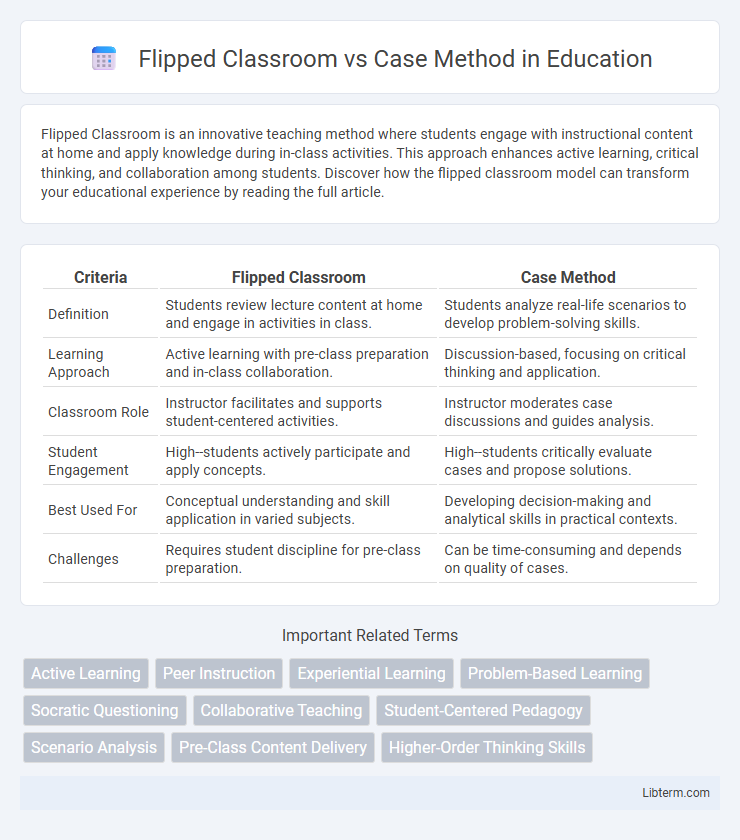Flipped Classroom is an innovative teaching method where students engage with instructional content at home and apply knowledge during in-class activities. This approach enhances active learning, critical thinking, and collaboration among students. Discover how the flipped classroom model can transform your educational experience by reading the full article.
Table of Comparison
| Criteria | Flipped Classroom | Case Method |
|---|---|---|
| Definition | Students review lecture content at home and engage in activities in class. | Students analyze real-life scenarios to develop problem-solving skills. |
| Learning Approach | Active learning with pre-class preparation and in-class collaboration. | Discussion-based, focusing on critical thinking and application. |
| Classroom Role | Instructor facilitates and supports student-centered activities. | Instructor moderates case discussions and guides analysis. |
| Student Engagement | High--students actively participate and apply concepts. | High--students critically evaluate cases and propose solutions. |
| Best Used For | Conceptual understanding and skill application in varied subjects. | Developing decision-making and analytical skills in practical contexts. |
| Challenges | Requires student discipline for pre-class preparation. | Can be time-consuming and depends on quality of cases. |
Introduction to Flipped Classroom and Case Method
Flipped Classroom reverses traditional teaching by delivering instructional content, often online, outside of the classroom, enabling interactive, problem-solving activities during class time. The Case Method engages students through real-world scenarios and decision-making exercises, fostering critical thinking and practical application of theoretical knowledge. Both methodologies emphasize active learning but differ in structure and focus, with Flipped Classroom prioritizing pre-class preparation and Case Method centering on in-class discussion.
Core Principles of Flipped Classroom
The Flipped Classroom centers on reversing traditional teaching by delivering instructional content outside of class, typically through videos or readings, allowing in-class time for active learning and problem-solving. Core principles include student-centered learning, where learners engage with foundational materials independently, and collaborative in-class activities that deepen understanding through discussion and application. This approach enhances engagement and retention by promoting continuous interaction between students and instructors during class sessions.
Foundations of the Case Method Approach
The Foundations of the Case Method Approach center on analyzing real-world scenarios to develop critical thinking and decision-making skills, encouraging active participation through discussion and debate. Unlike the Flipped Classroom, which reverses traditional learning by delivering content outside class and using class time for exercises, the Case Method immerses students directly in complex, context-rich problems. This approach enhances practical application of theoretical knowledge and fosters collaborative learning, essential for disciplines like law, business, and medicine.
Differences in Classroom Dynamics
The flipped classroom shifts the traditional lecture outside of class time, allowing in-person sessions to focus on active learning, student collaboration, and personalized instructor support. The case method emphasizes real-world problem-solving through group discussion and critical analysis of specific scenarios, fostering debate and diverse perspectives. While flipped classrooms prioritize individual preparation followed by interactive activities, case method classrooms rely heavily on spontaneous dialogue and instructor-led questioning to guide learning.
Student Engagement: Flipped vs Case-Based Learning
Flipped Classroom enhances student engagement by encouraging active participation through pre-class content review and in-class interactive activities, fostering deeper understanding and critical thinking. Case Method learning drives engagement by immersing students in real-world scenarios, promoting analytical skills and collaborative problem-solving during class discussions. Both methods increase engagement but differ in approach: Flipped Classroom leverages individual preparation, while Case Method centers on experiential group learning.
Preparation and Implementation Challenges
Flipped Classroom requires significant upfront preparation, including creating or curating video lectures and interactive materials, which demands time and technological skills from educators. In contrast, the Case Method involves designing complex, real-world scenarios and guiding dynamic discussions, posing challenges in maintaining student engagement and ensuring diverse perspectives are addressed. Both methods require careful implementation to balance content coverage with active learning, but Flipped Classroom struggles more with student accountability for pre-class preparation, while Case Method faces difficulties in moderating and facilitating effective group interactions.
Assessment and Evaluation Strategies
Assessment in the Flipped Classroom emphasizes formative strategies such as quizzes, peer feedback, and in-class activities that measure ongoing understanding and application of pre-class materials. The Case Method relies heavily on qualitative evaluation through class participation, critical thinking, and problem-solving demonstrated during case discussions. Both approaches integrate self-assessment and reflective exercises to promote deeper learning and continuous improvement.
Technology Integration in Both Methods
The flipped classroom leverages technology by providing pre-recorded lectures and digital resources for students to study independently, enhancing personalized learning and freeing classroom time for interactive activities. In contrast, the case method integrates technology through multimedia case presentations, online discussions, and collaborative platforms that facilitate real-time analysis and group problem-solving. Both methods rely on learning management systems and digital tools to support engagement, but the flipped classroom emphasizes content delivery, while the case method focuses on applying knowledge interactively.
Advantages and Disadvantages Comparison
The Flipped Classroom enhances student engagement by allowing learners to review content at their own pace before class, promoting active in-class participation and personalized feedback, but it requires high self-discipline and reliable access to technology. The Case Method cultivates critical thinking and real-world problem-solving skills through collaborative analysis of complex scenarios, though it can be time-intensive and challenging for students unfamiliar with open-ended discussions. Both methods foster deep learning but vary in implementation demands and suitability depending on course objectives and student readiness.
Choosing the Right Approach for Your Course
Selecting the right teaching method depends on the course objectives, student engagement goals, and content complexity; the Flipped Classroom enhances active learning by delivering lectures online and using class time for interactive activities, while the Case Method emphasizes critical thinking through real-world problem analysis in group discussions. Courses requiring practical application and immediate feedback benefit from the Flipped Classroom, whereas programs focused on strategic decision-making and ethical dilemmas are well-suited for the Case Method. Understanding your students' learning preferences and the specific skills you aim to develop is crucial when deciding between these approaches.
Flipped Classroom Infographic

 libterm.com
libterm.com